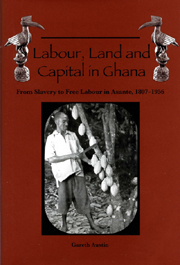Book contents
- Frontmatter
- Contents
- List of Illustrations
- List of Tables
- Preface
- Note on Names
- Maps
- Note on the Maps
- 1 Introduction
- Part I Context and Concepts
- Part II Social Relations of Production and Trade, 1807–1896: Absent and Imperfect Factor Markets
- Part III Slavery as Hobson's Choice: An Analysis of the Interaction of Markets and Coercion in Asante's Era of ‘Legitimate Commerce’, 1807–1896
- Part IV The Decline of Coercion in the Factor Markets of Colonial Asante: Cocoa and the Ending of Slavery, Pawnship and Corvée, 1896–c.1950
- Part V Social Relations of Production and Trade, 1908–1956: Towards Integrated Factor Markets?
- 14 Land Tenure: What Kind of Transformation under Cash-Cropping and Colonial Rule?
- 15 Capital and Credit: Locking Farms to Credit
- 16 Free Labour: Family Workers, the Spread of Wage Contracts, and the Rise of Sharecropping
- Part VI Freedom and Forest Rent, 1908–1956
- Abbreviations Used in the Notes
- Notes
- List of References
- Index
16 - Free Labour: Family Workers, the Spread of Wage Contracts, and the Rise of Sharecropping
from Part V - Social Relations of Production and Trade, 1908–1956: Towards Integrated Factor Markets?
Published online by Cambridge University Press: 12 September 2012
- Frontmatter
- Contents
- List of Illustrations
- List of Tables
- Preface
- Note on Names
- Maps
- Note on the Maps
- 1 Introduction
- Part I Context and Concepts
- Part II Social Relations of Production and Trade, 1807–1896: Absent and Imperfect Factor Markets
- Part III Slavery as Hobson's Choice: An Analysis of the Interaction of Markets and Coercion in Asante's Era of ‘Legitimate Commerce’, 1807–1896
- Part IV The Decline of Coercion in the Factor Markets of Colonial Asante: Cocoa and the Ending of Slavery, Pawnship and Corvée, 1896–c.1950
- Part V Social Relations of Production and Trade, 1908–1956: Towards Integrated Factor Markets?
- 14 Land Tenure: What Kind of Transformation under Cash-Cropping and Colonial Rule?
- 15 Capital and Credit: Locking Farms to Credit
- 16 Free Labour: Family Workers, the Spread of Wage Contracts, and the Rise of Sharecropping
- Part VI Freedom and Forest Rent, 1908–1956
- Abbreviations Used in the Notes
- Notes
- List of References
- Index
Summary
The purpose of this chapter is to document and clarify the variety of ways in which labour was put to work in the cocoa economy after the prohibition of slavery and pawning. The first three sections consider the importance of non-market inputs: from the farmer and from his or her spouse (a matter to be related to the gender distribution of farm ownership); from children; and from the cooperative work (nnɔboa) group. We then consider the origins of a wage labour market in rural Asante, initially in carrying and on the mines, c.1900–c.1920; describe the spread of regular wage labour, from c.1916 to the mid-1930s, mostly recruited from men, and mostly from the savanna; and document a remarkable transition from regular wage-labour to sharecropping contracts, from the late 1930s onwards. Finally, we examine state policy on rural labour.
Self and Spouse Labour in the Context of Mostly Male Ownership of Cocoa Farms
The most widespread form of cocoa-farm labour, throughout the period, was the farmer him or herself. In gender terms, the vast majority of the early cocoa farmers were male. Though female cocoa farmownership rose gradually throughout the period, by the end of it women were still very much a minority among cocoa farmers. The next most widespread category of cocoa labour was that of help from spouses. The implication of the distribution of farm ownership is that in the great majority of cases this meant wives helping husbands rather than the other way round.
- Type
- Chapter
- Information
- Labour, Land and Capital in GhanaFrom Slavery to Free Labour in Asante, 1807–1956, pp. 304 - 322Publisher: Boydell & BrewerPrint publication year: 2005

